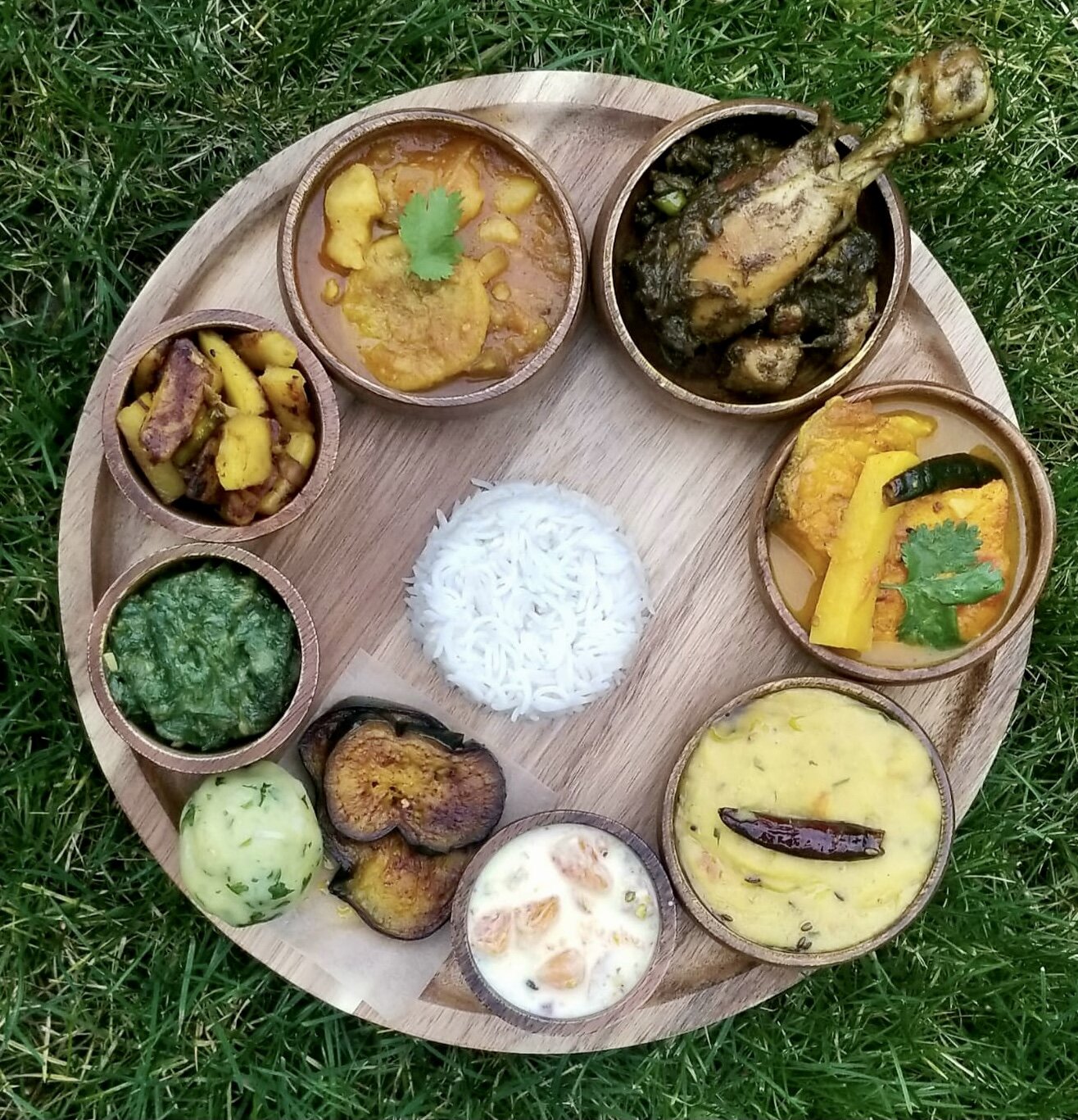Assamese Thali
After a small hiatus, we got back to working on our Weekend Thali Project. We decided to cook a thali from the state of Assam. Thinking about Assam always takes me back to my childhood when we went on a family vacation visiting Shillong, Guwahati and Cherrapunji (located in Meghalaya). The memory I remember the most from that vacation is the magnanimity of the River Brahmaputra when we took a small ferry to visit the Umananda temple located on a small island on the river near Guwahati. It is no surprise that it is the widest river in India. I don’t remember much about the Assamese cuisine from that vacation but Vikram has eaten a few Assamese dishes before. Nevertheless, there were still a few dishes that were completely new to us and we thoroughly enjoyed cooking them for the first time.
Lai Xaak Khar (Link to recipe)
Khar is an integral part of Assamese cuisine. The Khar is an alkaline based delicacy that can be made with Papaya, Banana stem or in this case mustard greens. The authentic khar dishes are generally cooked using an alkali made out of dried banana peels. But you can replace this by baking soda as well. Overall this dish had a very subtle and earthy taste and served as a palate cleanser. I was personally excited to find another way of preparing mustard greens than the usual Sarson ka saag recipe.
Aloo Pitika (Link to recipe)
This dish is a signature Assamese comfort food. The mashed potatoes in this dish are greatly enhanced by the heat of the green chillies, the sharpness of the raw onions and the earthiness of the mustard oil.
Masoor and Mung Dal (Link to recipe)
A really simple but wholesome lentil dish made out of masoor and moong dal - the tadka cooked in mustard oil is what sets this dish apart. This dish was also approved by our daughter!!
Assamese Style Aloo Fry (Link to recipe)
I’ll be honest - I added another potato dish to the menu because this was a recipe by Ranveer Brar and I am a huge fan. This dish is all about the kalonji (nigella seeds) and the chillies which gave the potatoes an Eastern India twist. Simplicity at it’s best!!
Begun Bhaja (Link to recipe)
This is a dish popular in a lot of the Eastern Indian states like Assam, Odisha and Bengal. There are variations to this dish that include rice flour or besan to add a bit more crunchiness to the eggplant. In this particular variation I did not add either and followed the recipe as is.
Boror Tenga (Link to recipe)
The tenga is a sour dish that is normally consumed as the last dish of an Assamese thali. While the Masor Tenga (the fish curry featured below), is the more popular variation, this lentil fritter tenga dish is a close second. The Boror (lentil fritters) were made out of Masoor dal, shallow fried and added to the simple sour tomato gravy tempered with panch phoron (a five spice blend comprising of cumin seeds, mustard seeds, nigella seeds, fennel seeds, and fenugreek seeds). As our daughter taught us, these lentil fritters were also excellent eaten individually as an appetizer.
Til Diya Murgi Mangxo (Link to recipe)
A chicken dish cooked in a gravy made out of black sesame seeds and black peppercorn - this was the biggest surprise of the meal. This was the first time we cooked anything with black sesame seeds and the taste was simply exquisite. Interestingly, there were no green leafy vegetables added to this dish even though it looked green.
Masor Tenga (Link to recipe)
No Assamese meal is complete without fish. This is the tenga (sour gravy) dish that is usually made out of Rohu fish, but we used Black Cod instead. The potatoes in the dish balanced the sourness in the gravy and created a light and tangy dish that paired excellently with steamed rice.
Komolar Kheer (Link to recipe)
This was an extremely interesting dessert. The kheer was made almost as a rabdi and then chilled. Just before serving, orange pulp and pistachios were added making it a refreshing dessert.
We found that while the usage of mustard oil and Panch Phoron was similar to the Odisha and Bengali cuisine, there were still some unique differences in the Assamese thali - with the Khar, the Tenga and the usage of black sesame seeds in the gravy.
Although I have no memories of the Assamese cuisine from before, I really appreciated how cooking this meal helped rekindle forgotten memories of a childhood vacation and enabled me to share this with my daughter. The added bonus is that I can now also boast to Vikram that I have seen the widest river in India (Brahmaputra) and the second wettest place in the world (Cherrapuji) ;-)









